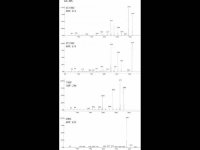EugeneOregon
Member
Used gear is finnicky but the unit does indeed work. In this short analysis methanol is used as the solvent. Delta 9 has several wavelengths of light that it is known to absorb and is fairly close to Delta 8 and to CBN. The granddaddy marker of THC though is found at 299 nm (UV) on the light spectrum. Google "light spectra" and you can relate a "nm" rating to a color. You will see 299 nm is on the far Side of the spectra opposite infrared (IR). Each molecule absorbs light at specific unique wavelengths. Once these wavelengths are known, the compound can then be spotted in a solution. This device marries up nicely to my liquid chromatography experiments! I can scan each fraction and get a precise picture about what is in it. Since I am interested mostly in just THC, if the fraction that elutes shows no peak at 299 nm, then I know with certainty there is no THC in the sample - it gets flushed...lolz.
This is a dual beam spectrophotometer capable of scanning 190nm-1100nm at 1 nm increments. The unit identifies peaks and valleys for the operator.
There are NUMEROUS modes that really buff this thing out but for me just being able to shine a "light" on something and see THC is constitutes an area of science known long by me to fall into the FM (Fucking Magic) range of discoveries... enjoy.
https://www.youtube.com/watch?v=mxOPJ1D44Wg
This is a dual beam spectrophotometer capable of scanning 190nm-1100nm at 1 nm increments. The unit identifies peaks and valleys for the operator.
There are NUMEROUS modes that really buff this thing out but for me just being able to shine a "light" on something and see THC is constitutes an area of science known long by me to fall into the FM (Fucking Magic) range of discoveries... enjoy.
https://www.youtube.com/watch?v=mxOPJ1D44Wg



